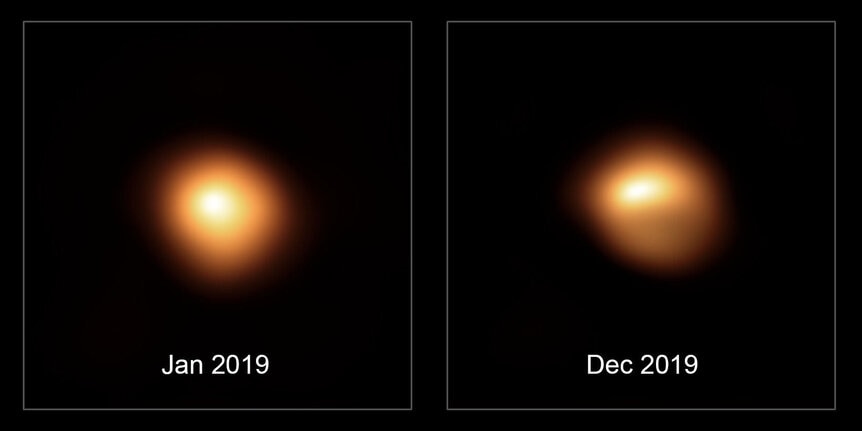Create a free profile to get unlimited access to exclusive videos, sweepstakes, and more!
The red hypergiant VY CMa is bigger than Betelgeuse and belching out vast clouds of dust

When it comes to star sizes, there are dwarfs, there are giants, and there are supergiants.
And then there are hypergiants.
These are very massive stars that live fast, die young, and go out with an enormous bang: Supernovae. And now we know that before they go they also suffer from coughing fits: epic eruptions of clouds of dust that scream away at high speed, causing the star to change rapidly and profoundly in brightness.
If that sounds familiar, yeah, keep Betelgeuse in mind. We'll get back to it.
But in this case we're talking about the star VY Canis Majoris (or VY CMa for short). This ridiculously bloated red hypergiant is about 4,000 light years away in the constellation of Canis Major, the Big Dog (one of Orion's hunting dogs). In this case, the constellation is appropriate: VY CMa is an immense star, well over 2 billion kilometers wide.
For comparison, the Sun is 1.4 million km across. VY CMa is over a thousand times larger. A thousand. Replace the Sun with VY CMa and it would stretch nearly to the orbit of Saturn.
That would be too bad for Earth. We'd be inside it. And given that the star generates several hundred thousand times the energy of the Sun, our planet wouldn't last long there.
So yeah, this star is crushing in every aspect. Stars like this don't last long, only a few million years, and as they age they generate so much light that they blow off their own surfaces, the matter there flung away by the intensity of the radiation from below. VY CMa probably started off with as much as 40 times the Sun's mass, but has already lost roughly half that. And this is where our story really begins.
Observations of the star show that it is blasting out way too much infrared light for a star of its kind, which is a telltale sign that it's surrounded by dust. This is usually microscopic grains of rocky (silicate-laden) or carbonaceous (sooty) material around the star (so we call it circumstellar, which is just a cool word). It's warmed by the starlight and so it glows in the infrared, causing the observed excess.
Extremely high-resolution observations of VY CMa show this dust, and they also show it's pretty complex. There are knots, clumps, arcs, and diffuse clouds around the star. New observations using Hubble, though, allowed astronomers to measure the speed at which all this dust is moving — much of it was ejected at tens of thousands of kilometers per hour. Fast. VY CMa does things big.
The beauty of this is that they then measured the distance from the star to these various clumps and used that in conjunction with the velocity to trace the clumps backwards in time, to see when they got ejected. What they found is interesting indeed… the ages of the various clumps and other features indicate they were blown off the star around 70, 120, 200, and 250 years ago.
Looking at historical observations of the star, these periods coincide with times of great brightness variability in the star, dimming and brightening by a large factor.
In other words, some physical mechanism in the star caused it belch out these huge clouds of dust, and these clouds then passed between us and the star, dimming it. The last great eruption was in the late1800s, when the star faded a great deal. It used to be naked-eye visible (barely) but after that eruption it dimmed and hasn't really brightened since.
And that is so very interesting because everyone's favorite not-quite-yet explodey star Betelgeuse just underwent a tremendous dimming event in late 2019. For several months the star shone at half its usual ruddy hue, and astronomers are still arguing over what caused it. The two main contenders are a cooling effect that dropped its luminosity, and the other is — you guessed it — eruptions of dust that blocked the star. I actually prefer the latter explanation; there's copious dust around Betelgeuse, and we know it sometimes blows this material off in big clouds. But a temperature drop can't yet be ruled out.
Still, Betelgeuse is a red supergiant. Lower mass, smaller, and not as luminous as VY CMa (which, after all, is one of the most luminous stars in the entire galaxy), but very similar. If VY CMa is blowing off dust and dimming, then it makes sense the same thing could be going on with Big B.
There are other differences, some of which are important though. Betelgeuse is a regular variable star, undergoing cyclic changes in brightness on the order of a year due to physics going on deep in its lower atmosphere. VY CMa is an irregular variable, and the changes in its brightness take many years to complete, are more likely due to things going on it its very upper atmosphere. So you have to be careful extrapolating from one star to the other. But still, it's a provocative idea.
Stars like this fascinate and terrify me. It's hard to grasp just how soul-crushingly immense they are, how powerful, and how they live their lives. But they're crucial for galactic evolution; they create heavy elements like iron in their cores which gets distributed throughout space when they explode. This material then goes into making new stars, new planets… and us. Literally, me and you.
The iron in your blood pumped through your body was once in the core of an exploding star like VY CMa, which pumped it first into the galaxy. If that alone isn't reason enough to study stars like that, nothing is.






























